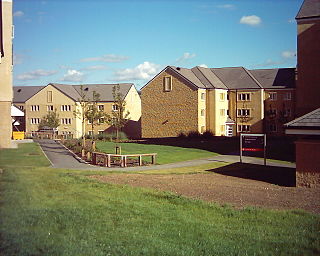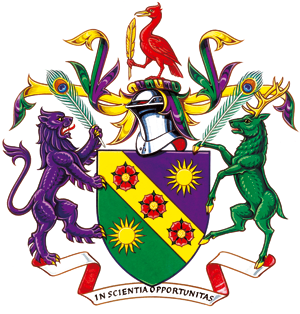
The University of New England (UNE) is a public university in Australia with approximately 22,500 higher education students. Its original and main campus is located in the city of Armidale in northern central New South Wales. UNE was the first Australian university established outside a capital city.

Armidale is a city in the Northern Tablelands, New South Wales, Australia. Armidale had a population of 29,317 as of June 2022. It is the administrative centre for the Northern Tablelands region. It is approximately halfway between Sydney and Brisbane at the junction of the New England Highway and Waterfall Way.

This is a list of halls of residence on the various campuses of the University of Nottingham in Nottingham, England.

The Women's College is a residential college within the University of Sydney, in the suburb of Camperdown, Sydney, New South Wales, Australia. It was opened in 1892.

St. John Fisher College, known simply as John Fisher College and familiarly referred to as "Fisher", is a residential college of the University of Tasmania. It was established in 1963 by the Archbishop of Hobart Sir Guilford Young and built by the Catholic Church and its community. The building was designed by notable Tasmanian architect Rod Cooper. The college was named after 16th century scholar St John Fisher and provides accommodation for around 110 students. It is located in Upper Sandy Bay, Tasmania, Australia, on campus at the University of Tasmania.

Christ College is the oldest tertiary institution in Australia and is a residential college of the University of Tasmania.

Cartmel College is a residential college of Lancaster University, England and was founded in 1968. It is named after the Cartmel Peninsula of "Lancashire north of the sands" which was once known as The Land of Cartmel. The college buildings were originally sited at the north end of the university's Bailrigg campus and extended in 1969. In 2004, the college was relocated around Barker House Farm in a new development in the southwest of the campus called Alexandra Park.

Pendle College is one of the constituent colleges of the University of Lancaster, England. Founded in 1974, the college is named after the Pendle witches of 1612, from the area around Pendle Hill in East Lancashire. The term "Pendle" is associated with a great deal of fantasy and legend.

Queen's College is a residential college affiliated with the University of Melbourne providing accommodation to more than 300 students who attend the University of Melbourne, the Victorian College of the Arts, RMIT University and Monash University Faculty of Pharmacy and Pharmaceutical Sciences.

The Presbyterian Ladies' College, Sydney is an independent Presbyterian single-sex early learning, primary and secondary day and boarding school for girls, located in Croydon, an inner-western suburb of Sydney, New South Wales, Australia. The school has a non-selective enrolment policy for all years except Year 11, and caters for approximately 1,250 girls from age four to age eighteen, including 65 boarders. Students attend PLC from all regions of the greater metropolitan area, New South Wales, and overseas.

The Presbyterian Ladies' College, Armidale is an independent, Presbyterian, day and boarding school for girls. The school is located in Armidale, a large rural town with a population of 28,000 in the New England region of New South Wales, Australia.

David Henry Drummond was an Australian politician and farmer. He was a member of the Country Party and served in both the New South Wales Legislative Assembly (1920–1949) and the Australian House of Representatives (1949–1963).

Edge Hill University is a campus-based public university in Ormskirk, Lancashire, England. The university, which originally opened in 1885 as Edge Hill College, was the first non-denominational teacher training college for women in England, before admitting its first male students in 1959. In 2005, Edge Hill was granted Taught Degree Awarding Powers by the Privy Council and became Edge Hill University on 18 May 2006.
Austin College is a college at the University of New England, Armidale, NSW, Australia. It is the second youngest of the established colleges, opening as an all girls college in 1972 . It proceeded to change to a co-ed tertiary residential college, which it remains to this day.

Ashburne Hall is a University of Manchester hall of residence for students on the Fallowfield Campus, situated 2 miles (3.2 km) south of the main university campus. The hall has catered accommodation offered to mainly undergraduate students, though some places are reserved for postgraduate students.

International House was the oldest residential college of the University of Wollongong, and is an affiliate of the 16 International Houses Worldwide. The establishment is now known as iHouse and provides accommodation to approximately 222 students who are attending the University of Wollongong.
There are ten residential colleges affiliated with ANU—Bruce Hall, Ursula Hall, Burgmann College, John XXIII College, Toad Hall, Burton & Garran Hall, Graduate House, Fenner Hall, Wamburun Hall and Wright Hall.

Howard Hinton was an Australian art patron and benefactor. A thwarted artist due to shortsightedness, he visited many of the great galleries of Europe in his youth. At age 24 he migrated to Australia and quickly associated with leading artists of the Heidelberg School and the bohemian artists' camps around Sydney Harbour in the 1890s. He built a successful career in shipping and, along with a family inheritance, used his moderate wealth to support waves of Australian artists in the first half of the twentieth century. Through extensive donations to the Art Gallery of New South Wales and particularly the Armidale Teachers' College he became one of the greatest benefactors in Australian art history.

The Armidale Teachers' College is a heritage-listed former tertiary college at 122–132 Mossman Street, Armidale, Armidale Regional Council, New South Wales, Australia. It was designed by the New South Wales Government Architect and built from 1928 to 1931 by the NSW Public Works Department. The property is owned by the Government of New South Wales, and currently managed by NSW Crown Lands pending a permanent manager. It was added to the New South Wales State Heritage Register on 8 November 2006.

Bishop Cosin's Hall was a college of the University of Durham, opened in 1851 as the university's third college and named after 17th century Bishop of Durham John Cosin. It closed in 1864 due to a fall in student recruitment at the university.


















